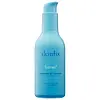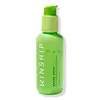What's inside
What's inside
 Key Ingredients
Key Ingredients

 Benefits
Benefits

 Concerns
Concerns

 Ingredients Side-by-side
Ingredients Side-by-side

Water
Skin ConditioningSodium Methyl Cocoyl Taurate
CleansingCocamidopropyl Hydroxysultaine
CleansingGlycerin
HumectantCaprylyl/Capryl Glucoside
CleansingSodium Cocoyl Isethionate
CleansingGlycol Distearate
EmollientBetaine
HumectantPanthenol
Skin ConditioningChondrus Crispus Extract
Skin ConditioningAloe Barbadensis Leaf Juice
Skin ConditioningGluconolactone
Skin ConditioningSodium Hyaluronate
HumectantJojoba Oil/Macadamia Seed Oil Esters
Skin ConditioningSqualene
EmollientPhytosteryl Macadamiate
Skin ConditioningPhytosterols
Skin ConditioningTocopherol
AntioxidantPropanediol
SolventHydroxypropyl Guar Hydroxypropyltrimonium Chloride
Xanthan Gum
EmulsifyingPolyacrylate Crosspolymer-6
Emulsion StabilisingSodium Chloride
MaskingEthylhexylglycerin
Skin ConditioningCitric Acid
BufferingBenzoic Acid
MaskingPhenethyl Alcohol
MaskingPentylene Glycol
Skin ConditioningTrisodium Ethylenediamine Disuccinate
T-Butyl Alcohol
PerfumingSodium Hydroxide
BufferingSodium Benzoate
MaskingPhenoxyethanol
PreservativeWater, Sodium Methyl Cocoyl Taurate, Cocamidopropyl Hydroxysultaine, Glycerin, Caprylyl/Capryl Glucoside, Sodium Cocoyl Isethionate, Glycol Distearate, Betaine, Panthenol, Chondrus Crispus Extract, Aloe Barbadensis Leaf Juice, Gluconolactone, Sodium Hyaluronate, Jojoba Oil/Macadamia Seed Oil Esters, Squalene, Phytosteryl Macadamiate, Phytosterols, Tocopherol, Propanediol, Hydroxypropyl Guar Hydroxypropyltrimonium Chloride, Xanthan Gum, Polyacrylate Crosspolymer-6, Sodium Chloride, Ethylhexylglycerin, Citric Acid, Benzoic Acid, Phenethyl Alcohol, Pentylene Glycol, Trisodium Ethylenediamine Disuccinate, T-Butyl Alcohol, Sodium Hydroxide, Sodium Benzoate, Phenoxyethanol
Aloe Barbadensis Leaf Juice
Skin ConditioningWater
Skin ConditioningCocamidopropyl Hydroxysultaine
CleansingGlycerin
HumectantSodium Methyl 2-Sulfolaurate
CleansingSodium Lauroyl Methyl Isethionate
CleansingLactic Acid
BufferingPyrus Malus Fruit Extract
Skin ConditioningNiacinamide
SmoothingSorbeth-230 Tetraoleate
EmulsifyingDisodium 2-Sulfolaurate
CleansingLactobacillus Ferment
Skin ConditioningDecyl Glucoside
CleansingLauryl Glucoside
CleansingMusa Sapientum Fruit Extract
Skin ConditioningRubus Idaeus Fruit Extract
AstringentPyrus Communis Fruit Extract
Skin ConditioningPrunus Armeniaca Kernel Extract
Skin ConditioningMelia Azadirachta Leaf Extract
Skin ConditioningMelia Azadirachta Flower Extract
Skin ConditioningCorallina Officinalis Extract
Skin ConditioningCoccinia Indica Fruit Extract
Skin ConditioningSolanum Melongena Fruit Extract
Skin ConditioningAloe Barbadensis Flower Extract
EmollientCurcuma Longa Root Extract
MaskingOcimum Sanctum Leaf Extract
Skin ConditioningOcimum Basilicum Flower/Leaf Extract
TonicSodium Gluconate
Skin ConditioningHydroxyethylcellulose
Emulsion StabilisingSodium Laurylglucosides Hydroxypropylsulfonate
CleansingSodium Chloride
MaskingSorbitan Oleate Decylglucoside Crosspolymer
CleansingSorbitan Laurate
EmulsifyingSodium PCA
HumectantOpuntia Ficus-Indica Stem Extract
Skin ConditioningDisodium Phosphate
BufferingPanthenol
Skin ConditioningRiboflavin
Cosmetic ColorantSodium Hydroxide
BufferingPhenoxyethanol
PreservativeEthylhexylglycerin
Skin ConditioningPotassium Sorbate
PreservativeAloe Barbadensis Leaf Juice, Water, Cocamidopropyl Hydroxysultaine, Glycerin, Sodium Methyl 2-Sulfolaurate, Sodium Lauroyl Methyl Isethionate, Lactic Acid, Pyrus Malus Fruit Extract, Niacinamide, Sorbeth-230 Tetraoleate, Disodium 2-Sulfolaurate, Lactobacillus Ferment, Decyl Glucoside, Lauryl Glucoside, Musa Sapientum Fruit Extract, Rubus Idaeus Fruit Extract, Pyrus Communis Fruit Extract, Prunus Armeniaca Kernel Extract, Melia Azadirachta Leaf Extract, Melia Azadirachta Flower Extract, Corallina Officinalis Extract, Coccinia Indica Fruit Extract, Solanum Melongena Fruit Extract, Aloe Barbadensis Flower Extract, Curcuma Longa Root Extract, Ocimum Sanctum Leaf Extract, Ocimum Basilicum Flower/Leaf Extract, Sodium Gluconate, Hydroxyethylcellulose, Sodium Laurylglucosides Hydroxypropylsulfonate, Sodium Chloride, Sorbitan Oleate Decylglucoside Crosspolymer, Sorbitan Laurate, Sodium PCA, Opuntia Ficus-Indica Stem Extract, Disodium Phosphate, Panthenol, Riboflavin, Sodium Hydroxide, Phenoxyethanol, Ethylhexylglycerin, Potassium Sorbate
 Reviews
Reviews

Ingredients Explained
These ingredients are found in both products.
Ingredients higher up in an ingredient list are typically present in a larger amount.
Aloe Barbadensis Leaf Juice comes from leaves of the aloe plant. Aloe Barbadensis Leaf Juice is best known for helping to soothe sunburns. It is also anti-inflammatory, moisturizing, antiseptic, and can help heal wounds.
Aloe is packed with good stuff including Vitamins A, C, and E. These vitamins are antioxidants, which help fight free-radicals and the damage they may cause. Free-radicals are molecules that may damage your skin cells, such as pollution.
Aloe Barbadensis Leaf Juice also contains sugars. These sugars come in the form of monosaccharides and polysaccharides, folic acid, and choline. These sugars are able to help bind moisture to skin.
It also contains minerals such as calcium, 12 anthraquinones, fatty acids, amino acids, and Vitamin B12.
Learn more about Aloe Barbadensis Leaf JuiceCocamidopropyl Hydroxysultaine is a synthetic cleansing agent, though it is derived from coconut oil.
It is used to enhance the texture of products by boosting lather and thickening the texture. As a cleanser, Cocamidopropyl Hydroxysultaine is mild.
Ethylhexylglycerin (we can't pronounce this either) is commonly used as a preservative and skin softener. It is derived from glyceryl.
You might see Ethylhexylglycerin often paired with other preservatives such as phenoxyethanol. Ethylhexylglycerin has been found to increase the effectiveness of these other preservatives.
Glycerin is already naturally found in your skin. It helps moisturize and protect your skin.
A study from 2016 found glycerin to be more effective as a humectant than AHAs and hyaluronic acid.
As a humectant, it helps the skin stay hydrated by pulling moisture to your skin. The low molecular weight of glycerin allows it to pull moisture into the deeper layers of your skin.
Hydrated skin improves your skin barrier; Your skin barrier helps protect against irritants and bacteria.
Glycerin has also been found to have antimicrobial and antiviral properties. Due to these properties, glycerin is often used in wound and burn treatments.
In cosmetics, glycerin is usually derived from plants such as soybean or palm. However, it can also be sourced from animals, such as tallow or animal fat.
This ingredient is organic, colorless, odorless, and non-toxic.
Glycerin is the name for this ingredient in American English. British English uses Glycerol/Glycerine.
Learn more about GlycerinPanthenol is a common ingredient that helps hydrate and soothe the skin. It is found naturally in our skin and hair.
There are two forms of panthenol: D and L.
D-panthenol is also known as dexpanthenol. Most cosmetics use dexpanthenol or a mixture of D and L-panthenol.
Panthenol is famous due to its ability to go deeper into the skin's layers. Using this ingredient has numerous pros (and no cons):
Like hyaluronic acid, panthenol is a humectant. Humectants are able to bind and hold large amounts of water to keep skin hydrated.
This ingredient works well for wound healing. It works by increasing tissue in the wound and helps close open wounds.
Once oxidized, panthenol converts to pantothenic acid. Panthothenic acid is found in all living cells.
This ingredient is also referred to as pro-vitamin B5.
Learn more about PanthenolPhenoxyethanol is a preservative that has germicide, antimicrobial, and aromatic properties. Studies show that phenoxyethanol can prevent microbial growth. By itself, it has a scent that is similar to that of a rose.
It's often used in formulations along with Caprylyl Glycol to preserve the shelf life of products.
Chances are, you eat sodium chloride every day. Sodium Chloride is also known as table salt.
This ingredient has many purposes in skincare: thickener, emulsifier, and exfoliator.
You'll most likely find this ingredient in cleansers where it is used to create a gel-like texture. As an emulsifier, it also prevents ingredients from separating.
There is much debate on whether this ingredient is comedogenic. The short answer - comedogenic ratings don't tell the whole story. Learn more about comegodenic ratings here.
The concensus about this ingredient causing acne seems to be divided. Research is needed to understand if this ingredient does cause acne.
Scrubs may use salt as the primary exfoliating ingredient.
Learn more about Sodium ChlorideSodium Hydroxide is also known as lye or caustic soda. It is used to adjust the pH of products; many ingredients require a specific pH to be effective.
In small amounts, sodium hydroxide is considered safe to use. However, large amounts may cause chemical burns due to its high alkaline.
Your skin has a natural pH and acid mantle. This acid mantle helps prevent harmful bacteria from breaking through. The acid mantle also helps keep your skin hydrated.
"Alkaline" refers to a high pH level. A low pH level would be considered acidic.
Learn more about Sodium HydroxideWater. It's the most common cosmetic ingredient of all. You'll usually see it at the top of ingredient lists, meaning that it makes up the largest part of the product.
So why is it so popular? Water most often acts as a solvent - this means that it helps dissolve other ingredients into the formulation.
You'll also recognize water as that liquid we all need to stay alive. If you see this, drink a glass of water. Stay hydrated!
Learn more about Water